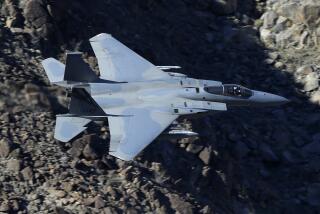The Quarterbacks of the Skies
- Share via
ABOARD THE USS ABRAHAM LINCOLN IN THE PERSIAN GULF — They drop no bombs. They shoot no missiles. Their work with scopes, monitors and coded messages seems more the realm of computer nerds than combat aces. Even their plane, with its signature radar dome, is clunky.
But those who fly and fix the E-2C Hawkeyes that provide early warning and a battlefield’s big picture are the linchpin of air, ground and naval war fighting. They are the angels on the shoulders of advancing infantry, summoning close-air support and warning of dangers beyond the horizon.
“The fighter guys are looking at targets, while we’re looking at communications and coordination and flows,” Lt. Aaron Brodsky, an E-2C mission commander, said of the eye-in-the-sky air crews attached to this aircraft carrier.
Fresh from a mission choreographing air and ground operations a day after the massive bombardment of Baghdad, Brodsky said the U.S. units advancing through southern Iraq rely on the Hawkeyes to summon cover or get assessments from forward troops of enemy positions they might encounter.
The E-2Cs also have the capacity to shrink or expand the battlefield, flying reconnaissance over no-man’s land to verify it’s clear of friendly forces before calling in airstrikes.
“We’re there to coordinate if they need extra resources. We can also prioritize targets or send aircraft into a holding pattern until an Army commander needs the bombs dropped. The battlefield is a very dynamic place and the E-2C’s flexibility is its biggest advantage,” Brodsky said.
The multi-tasking nature of the E-2C is referred to among crew members as its “motherhood” role, said Cmdr. George Fadok, head of the “Black Eagles” squadron on board. Like a den mother equipped to troubleshoot during a field trip, the Hawkeye takes care of diverse needs, demands and scenario changes.
“Whatever the overall mission, it’s almost always the same for us,” Fadok said of the erratic pace of the current conflict that has alternated missile barrages, massive airstrikes and relative lulls in bombardment while ground forces move forward.
The Hawkeyes deploy first during flight operations to provide the aerial eye for which they are nicknamed.
The carrier’s four E-2C aircraft launch throughout the day and night in leapfrog fashion, the arriving plane overlapping with the one going on duty until an electronic hand-over is completed.
While each squadron is “organic” to its carrier -- a permanent part of the air wing and familiar with its nuances -- the E-2Cs from all three carrier groups in the gulf are sharing air-traffic control and monitoring duties to cover an around-the-clock schedule of sorties.
The “Black Eagles,” with rotating five-person crews, are equipped to detect airborne threats, either planes or surface-to-air missiles, to coalition forces. They also ensure that any flight activity they detect is hostile before other aircraft are given shoot-down orders.
“If something is airborne and flying at a slow speed with its [landing] gear and flaps down, not making any evasive maneuvers, we can make the assumption that it’s a defector,” said Brodsky, 31, of Camarillo.
The wear and tear of carrier landings takes its toll on the E-2Cs, requiring disproportionate care to keep them flying. “For every hour of flying, it takes 14 hours of maintenance,” explained Petty Officer 2nd Class Ned Shanks of Sylmar.
Master Chief Petty Officer John Sais, a 26-year Navy veteran who is due to retire after the current deployment, said the unsung role of the Hawkeyes may be lost on the public but not on such war managers as Rear Adm. John M. Kelly, senior battle group commander in the gulf.
“Even though we don’t drop any bombs or shoot any missiles, we’re in the visibility of that two-star when he wants to know he’s got coverage,” Sais said.
More to Read
Sign up for Essential California
The most important California stories and recommendations in your inbox every morning.
You may occasionally receive promotional content from the Los Angeles Times.














